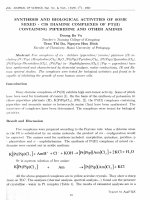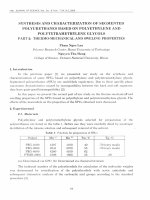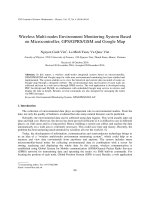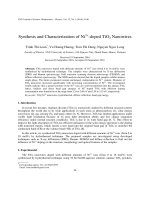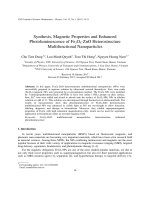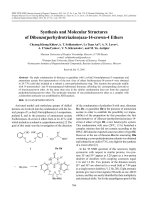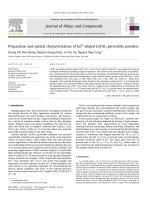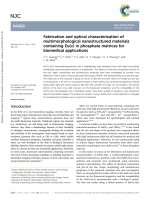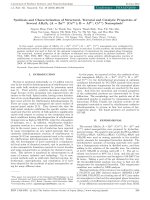DSpace at VNU: Synthesis and characterization of Segmented polyurethanes based on polyethylene and polytetramethylene glycols (part I: Synthesis and characterization)
Bạn đang xem bản rút gọn của tài liệu. Xem và tải ngay bản đầy đủ của tài liệu tại đây (1.16 MB, 7 trang )
VNU J O U R N A l OF
SCIENCE
N .i! .
So
y. Tech
ĩ XIX N 4. 2003
S Y N T H E S I S A N D ( H :\R A C T E R IZ A T IO N O F S E G M K N T E D
P O L Y U R K T H A N K S KASKI) O N P O L Y E T H Y L E N E A N D
POLYTKTKAM ETHYLENE GLYCOLS
( P a r t I: S y n t h e s i s a n d c h a r a c t e r i z a t i o n )
P ha nì N g o e L a n
/W v///í7* lỉrs c u rc h ( \ ‘n ti'r t H a noi ư n iv c rs itv ( ) / Technology
K. S c h a c h t
B io n ìa trrid ls P o lx n iịT ỉỉtn c a rc h G ro up , U n iv e rs ity o f G hent. B v lg iu m
1. In tro d u ctio n
S egm onted p o ly u re th a n e s (SPU s) are m u lt ib lo c k - f- X “ Y “ J“ copolym ers w h ich
ro n s is t o f th e rm o d v n a m ic a lly in c o m p a tib le segm ents. In these cop olym e rs. X and Y
are soft a n d harcl segm ent sequences re s p e c tiv e ly . D ue to th e th e rm o d y n a m ic
d iííe rim ce s o f th (‘ suít and h ĩirđ SL»|ỊnuMitS' th e y u s u a lly segrate to fo rm an agrugated
|).seiido-tw o-phase s tru c tu re s
m o rp h o lo g ica l
lw o -p h a se
111. SF>Us have good b io c o m p a tib ility
structurc*
and
c o n se q u e n tly
have
due to the
fo u n d
exte nsive
hiom ecỉical A p p lic a tio n s [2].
The
io n s h ip betvveun tiu* s trư c tu re s and p ro p e rtie s o f th e SPU s has been
rx te n s iv e lv in v e s tiịỊỉite d |3. l,5 |.
In th is p a p c r \VI* presen t the s tu d y on s y n th e s is and c h a ra c te riz a tio n ơf SPUs
hnsed on m a cro d io ls (p o ly e th v le n e and p o ly te tra m e th y le n e g lyco ls), m e th y le n e 1.4l)i(c y c lo h e x v l is o c y a n a ti1) (M I)C l) and 1,4-butane cỉiol (H I))(c h a in exte n d e r). The
rlĩec-ts o f m a cro d io ls. th í‘i r m o lo c u la r ra tio s on th e m o rp h o lo g y a n d p ro p e rtie s o f the
re s u ltin g p o lynu*rs wi»re (lisrussed.
2. E xp erĩm en tal
2.1. M a t e r ia ls
P o lve th ylo iu * and p o lv te ra m e th vlune glvcols selected fo r p re p a ra tio n ơf the
p o ly u re th u n c s are listecl in th e ta b ỉe I. Before use th e y w ere c a re íu lly d rie d bv
azeotropic c iis tilln tio n
of thi* to lu e n e s o lu tio n
and su b se q u e n t
re m ova l o f the
solvent. F ig u re 4(1 shows the IK sp e ctru m o f polyol PEG -2000.
The h y d ro x v l n u m b tT ()f p o lv o th e rd io ls fo r c a lc u la tio n o f m o le c u la r w e ig h ts
was d e te rm in e d hy r s t r r ií ì r í it ion of the m w ith acetic a n h y d rid e and subsequent
titrim etric
analysis
()f t h o
c a rb o x y lic
acid
procedurc (BỊ.
21
groups
a c c o rd in g
to
the
S tandard
22
P h a m Ngoe Lariy E. S c h a c h t
Table 1: P o lyd io ls fo r p re p a ra tio n o f SPU s
Polyol
M n '■»
M n
Tm . UC
Tg, “C
PEG-1000
1207
1100
40
• 70 (ve ry weak)
PEG-2000
2341
2070
55
•7Q (verv weak)
PEG-4000
4280
4109
62
-
PTM O -2000
2186
1950
25
•30
(a): Determined via GPC
(b): D e te rm in e d via ch e m ic a l titr a tio n
The m o le c u la r w e ig h ts o f th e p o ly d io ls w ere also v e riíìe d by m eans o f gel
p e rm e a tio n c h ro m a to g ra p h y (P L colu m ns, 103A°, 7m m i. d., 60 cm le n g th , P olym e r
L a b o ra to rie s L td , S h ro p s h ire , Ư K. E lu e n t: c h lo ro fo rm . D iíT e re n tia l re fle c to m e tric
d e te ctio n (M odel W a te rs 401, M illip o r e , M A , U SA). D a ta a n a ly s is o ccu rre d on a
Waters data module model M 7 30. Calibration was based on a peak p o sitio n
c a lib ra tio n curve e s ta b lis h e d u s in g p o lystyre n e s ta n d a rd s ( M illip o r e , M illío r d , M A ,
USA).
D iiso cya n a te (M D C I) (A ld ric h B ornem , B e lg iu m ) w as va cu u m d is tille d and
stored u n d e r d rie d c o n d itio n s in a re írig e ra to r p r io r to use. The IR sp e ctrum o f
M D C I is show n in fỉg u re 1
•1» »•*
F ig u re 1. IR s p e c tru m o f d iis o c y a n a te : M C D I
s> n th e s is (Itu ỉ c ì ì u r a v t c r ix a t in n of.
2\ \
1 .1-hutaiu* tlio l (A M rii lì. B ornem , lỉe lg iu m ) was d r ir d o v r r calc iu m h y d rid e for
‘J i l a y s . ( I i s t i l l i - í l 2 1 1 1 ( 1 s t o ỉ v d i m d t T m l r o ^ r n .
D i b u t v l t i n ( l i a t v t a t í * \v;i> u b t a i n e đ f r o n ì A l d r i r h ( l ỉ o r n r m ,
h r l | 4 i u m ) a n d usecỉ
w ith i)iit C u rtlu T p u n lii .itm n
D im r th y l
!nrm;»m nlt*
(A líiric h
lk 'ltfiu m )
was
(iric d
over
C ỉìlriiim h y đ r id r r<>r 2 <I;ìv > iin d thi*n vacuum d is tillr d .
2.2. C h a r a c t e r is a t io n m e th o d s
1R
sỊH T tra
Wt*rr
iv c o rd rd
u sin g
a
P e rk in -E lrrH T
M odel
1600
S p e rtro p h o to m i* trr
N M K s p c rtra VVIMV m o n l r d in I ) \ I S 0 ‘ (i„ u s in tf U *tra n u 'th v l s ila n i* (T M S ) as
in to rn a ỉ s tíin d a rd s . on an Aspcct .'Ỉ000 s p e ctro p h o to m e to r.
T he m o le c u la r vvei^hts and m o le c u la r vveight d is tr ib u tio n ()f the polym ers
YVI-n* d e te rm in e ci hy gvì ỊM /rm riitio n c h ro m a to g ra p h y (W a te rs associates. m odel 510)
at 60
c . Tht* flo w ratt* o f t l ì r so lvo n t. l-m e th y l-2 -p v rro lid in o n e (N M P ). was 1
m l.m in \ F o r c a lc u la tio n . m onodispersed polystyreru* s ta n d a rd s vverc uscd.
DSC th o rm o ^ ra m s were recorđed on a P e rk in -E lm e r DSC' u n d e r n itro g e n
p u rg in g (h c a tin g ra te lO C . m in 1, IVom -100°c to 1()0"C). The u n it was equipped
w ith a d a ta P rocessing m odulo th a t allovvs s u h s tra c tio n o f th e b a ckg ro u n d and
n o rm a liz a tio n fo r sam ple vveight.
2.3. P o ly m e r p r e p a r a t io n
S o lu tio n s o f p o ly d io i and (ỉiis o c y a n a te w ere p repa red s e p a ra te lv in 1)MF.
The c o n e e n tra tio n was a p p ro x im a to ly
15% (w /w ). A fou r*necke d íla s k , equipped
w ith a s tir r e r , a n itr o g r iì in le t and o u tle t and a th c rm o m e te r, w as cha rge d w ith the
diisocyanaU * s o lu tio n . T h e p o ly e th e rd io l s o lu tio n . c o n ta in in g 0.5 w t % o f c a ta ly s t
( d i b u t y l t i n d ia c e ta te ) based o n t h e w e i g h t « f t h e re a c ta n t, w a s a d d c d s l o w l y t o t h e
(In s o c v a n n tr s o lu tio n
c a rrie d o u t at 90
r
T he m o ln r r a tio N C O :O H was set to 2:1. T h í' re a c tio n was
u n d e r n itro g e n pu rge and vvas a llo w e d to proceed u n til the
th e o re tic a l iso cya n a te co n te n t was reached as d e te rm in e d hy th e d i-n -b u ty l am ine
titration method |7]. Then the reaction mixture was cooled down to room
to m p e ra tu re a n d thí* (h a m e x te n d tT (B D ) was ndded s lo w ỉy . T h i' o v e ra ll N C O :O H
ra tio was 1:1. T he c h a in e xte nsion rc a c tio n w as c a rrie d o u t at 90" c and c o n tin u e d
u n til a ll N C O group s w ere reactod, as co n firm e d by th e disa p p e a ra n ce o f the IR
a b s o rp tio n b iin đ at 2262 em
and the fin a l p o ly m e r
VVÍÌS
The m ic tio n m ix tu re was th e n p re c ip ila te d in w a te r
(Irie d u n d e r vacu um a t 60° c . A fte r d ry in g it was
redissolved in T H F and re p re e ip itn te d in the s o lv o n t m ix tu re h e x a n e -e th e r (1/1).
The co p o ly m e r prođu et was (Iried u n d e r vacuum a t 6 0 °c at le a s t fo r 2 ciays.
24
P h a m Ngoe L a n , E. S c h a c h t
3. R e su lts a n d d is c u s io n
3.1. S y n th e s is o f s e g m e n te d p o ly u re th a n e s
Segm ented
p o ly m e riz a tio n
p o ly u re th a n e s
(F ig u re
2).
(SPƯs)
P olyol
d iiso cya n a te . S u b se q u e n t c h a in
íìrs t
vvere
s y n th e s iz e d
reacted
exte nsion
w ith
tw o
was o b ta in e d
by
a
tw o -s te p
e q u iv a le n ts
by
re a c tio n
o f thí*
vvith
an
e q u iv a le n t am o u n t ()f 1,4-bu tan e d io l. The íìn a l p o ly m e r w as p u rifie d p ro p e rly hv
p re c ip ita tio n , va cu u m d rie d and th e n c h a ra c te riz e d . T h e m o le c u la r vveights o f th e
SPUs d e te rm in e d bv G PC m e th o d and are lis te d in ta b le 2.
2 0
=C =N -«=>N =C =
H
0
=C=N-c
0
o
•N-CO-
+
HO
OH
o
n
N = c=0
O C -N <
HO—□—OH (Chain extender)
H
H O
I
I
II
H( H D - 0 - C - N t = > - N - C O
0
V‘í
OC-N-c
n
F ig u re 2 : S ch e m a tic procedure o f segm ented p o ly u re th a n e fo rm a tio n
W c can see fro m th e ta b le 2 th a t a ll th e S P U s have q u ite h ig h m o le c u la r
w e ig h ts
and th e
m o le c u la r
w e ig h t d is tr ib u tio n
(d)
is
re la tiv e ly
n a rro w .
The
m a te ria ls o b ta in e d are s tro n g ns vvill be show n in th e n e x t p u b lic a tio n .
T able 2: M o le c u la r w e ig h ts o f S P U s
Code
. Polyol ra tio
Diiso-
C h a in
cyanate
exte nd er
Mw
d
P ư -l
PEG-1000 + P TM O -2000 (1/1)
MCDI
BD
60027
20
PU-2
PEG-2000 + m
i 0 -2 0 0 0 (1/1)
MCDI
BD
70815
1.9
PU-3
PEG-4000 + PTM O -2000 (1/1)
MCDI
BD
61593
1.8
PƯ-4
PEG-2000 + IT M O -2 0 0 0 (2/1)
MCDI
BD
108533
2.1
PU-5
PEG-2000 + P TM O -2000 (1/2)
MCDI
BD
66242
2.0
S x n th e s is a n d c h a r a c te t'iz a tin n o/.
25
3,2. N M R s p e r tr a
T h u stru ctu rc* ol thí* SPU s o b ta in e d was c o n firm e d bv p ro to n N M R spectra.
F ỉg u rc 3 shovvs th t' N M K sp e ctru m o f p o ly u re th a n e PU-2. W i' can seu th a t the
spect.rum show s rk * a rl\ ih t‘ peak at ổ = 1.6 ppm eo rru sp o n đ in # to |1-CH o f PTM O
and íì Ị)c‘ak at ổ =
1
ppni c o rre s p o n d in g to «-C H . oí’ P T M O and lM ííi.
F ig u re 3: 1M -N M R speetrum o f PU-2 (P E G -2000 + P T M O -200 0 (1/1)),
Solvent: C h l o r o t o r m
3.3. I I i ơ n a Ix s is
F o r c o n ip a ris io n , fig u re 4a show s the IR sp e ctru m o f polyol P EG -2000. We can
see c le a rlv th e c h a ra c te ris tic a b s o rp tio n band o f the O H -g ro u p a t ‘3447.9 cm 1w hich
was a lm o st d isa p p e a re d in p o lv u re th a n e fo rm a tio n and th e e th e r g ro u p a t 1119.5
cm
Bv p o lv u re th a n e fo rm in g , th e N C O g ro u p o f d iis o c y a n a tc d isa p p e a re d (2262.0
cm-1) (see fig u re /), b u t th e re appeared tw o new c h a ra c te ris tic groups: the N H group at 3323.1 cm 1 a n d c = 0 g ro u p a t 1712.8 cm 1 (F ig u re 4b).
T h o p o lv u re th a n e s are segm ented copolym ers c o n ta in in g íle x ib le p o ly e th e r
segm onts and h a rd segm onts o f isoeyanate m oeties. In th e h a rd segm ents o f the
SPUs. h vd ro g e n honds ơccur due to th e in te ra c tio n o f hyd rog en ato m s o f N H -g ro u p s
w ith c a rb o n y l groups. In the p o ly e th e r p o ly u re th a n e cop olym e rs, th e N H groups
form hydrogíMì bonds w ith the c = 0 groups o f th e u re th a n e lin k a g e s m a k in g the
harđ segm ents gootl packoci co n se q u e n tly the co p o lym e r w e ll phase separated. A t
the same tin u ỉ th e hydrogen bonds can occur due to th e in te ra c tio n bctw een th e NU
groups and th e oxvgen atom s o f th e soft segm ent e th e r groups. In th is case the
cop olym e r becomes k ầss phase separated. I t is
known fro m th e lite r a tu r e IH, 9| th a t
the IR a b s o rp tio n o f th e N H - and c = 0 groups
P h a m N goe L a n , E. S c h a c h t
26
N H - (H *bonded)
-►
-N H - (H -fre e )
->
3200 - 3350 cm
3360 - 3500 cm
- c =0
(H -b ond ed )
------- —►
1700 - 1714 cm
- c =0
(H -fre e )
-------
1715 - 1740 cm
As w t‘ can see fro m the fig u re 4b th a t the PƯ-5 is q i ite w e ll phase sep ara ted .
The same good phase s e p a ra tio n can also be seen in th e o th e r S P U s in v e s tig a te d in
th is vvork. T h e q u e stio n co n ce rn in g phase se p a ra tio n o f th e S P U s w ill be discussed
in m ore d e ta ils in th e p a rt II.
F ig u re 4. IR sp e ctru m ơf p o ly o l (4a) and p o ly u re th a n e P U -5 (4b)
S xn th e sis a n d c h a r a c t e r iz a t io n tỉf..
4.
27
C o n c lu s io n
In th is stu d y . thi* syn th e sis and c h a ra c te riz a tio n o f p o ly u th y lu n e and
po lytet ra n ic t h v lrn c tflv ro l lỉỉised SPUs w ere described. T h iĩ s tru c tu re ()f the SPUs
o h ta iiu ‘(l w as c o n lìrm c d hy tlìi* N M K and IR spectra. It VVHS shovvn th a i th e selected
s r u s to r th is s tiiílv híicl ( Ịiiilc goođ pha.se se p a ra tio n .
R e fe re n c*o s
1
C o o p e r S L . . T o b o l s k y A V . e/. A p pl. P olvm . S ci
2
Leiah M I) . Cooper SL . Polyurethanes ỉn medicine, Boca Raton, K I/ CRC Press (1986)
3
T a kỉih arn A . Tashita J
26( 1985) 978 996
4
Hwanp Lin s . Tsay s
10(1966), 1837*1845.
Kajiynma T-. Takayanngi M . M acknight w
Polvmer,
Cooper SL . Pohmer, 25(1984). 947*952.
1* N Lán. C orneillie s . Schacht K . Davies M and Shard A . Bìomateriữls, 17(1996)
2273-2280.
6
Su ri'n son WR.. ra m p b e ll TW
Interscienre, 1961
Preperatiưe Methods o f Polymers Chemistry, New York,
7
MaltH* KJ.. David 1)J., In David DJ, Staley HB., eds., A n a ly tic a l Chemistry o f
Polvurcthane. N rw York: Wiley, 86*90.
8.
Tanaka T . Yokoyama T . Yamaguchi Y., J. Polym. Sci. Part A ì, 1986, 0(1968) 21372152.
9
Jin-Lon# Hong, L illy n C l\, Chien JCW., Polymer, 33, 3247-3351 (1992).
TAP CHI K H O A HOC Đ H Q G H N , K HTN & CN, T.XiX. N04, 2003_________
TÓNCỈ h ợ p v à k h a o s á t t ỉ n h c h ấ t c ủ a c á c p o l y u r e t a n p h á n đ o ạ n
( P h ẩ n 1: T ô n g h ợ p v à k h ả o s á t t í n h c h â t )
P hạm N gọc L ã n
T ru n g tá m nghiên cứu polym e , Đ ạ i học Bach khoa H a N ộ i
E. S c h a c h t
T ập đoàn nghiên cứu vát liệ u polym e s in h học. D ạ i học G he nt. B i
Bài báo để cập vế nghiên cứu và khảo sát tín h c h ấ t của các p o ly u re ta n phân
đoạn trô n cơ sỏ p o ly e ty le n g ỉy c o l và p o ly te tra m e ty le n g ly c o l. Đà sử d ụ n g phương
pháp phố hồng ngoại (IR ) và cộng hưởng từ hạ t nhân p ro to n (1 H -N M R ) để xác đ ịn h
cấu trú c của các p o ly u re ta n th u được. Đã n g h iê n cứu ả n h hưởng của các m acrodiol
và tỷ lệ m ol của ch ú n g lôn h ìn h th á i học và tín h c h ấ t của sản p h ẩ m p o ly u re ta n .
Từ khóa: m a crn d io l. p o ly u re ta n phân đoạn, tách pha.

